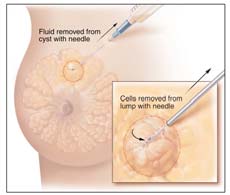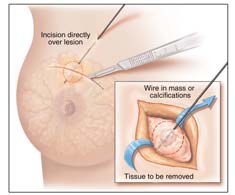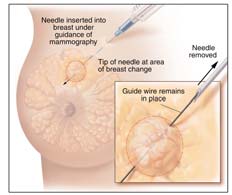|
Follow-Up Tests to Tell You More
Ultrasound
Biopsies
Types of Biopsies
Getting Your Biopsy Results
Doctors often use ultrasound or biopsies to follow up after finding signs of a breast change.
An ultrasound uses sound waves to make a picture of breast tissue. This picture is called a
sonogram. It helps doctors look more
closely at lumps. An
ultrasound shows if a lump is solid or filled with fluid
(cyst).
(See Chart 1: Possible Cysts are usually not cancer. Mammogram Results and Follow-Up Care.)
An ultrasound also can help
your doctor decide if more tests are needed.
It is important to know that
an ultrasound may not find all abnormal
changes.
A Cyst: The Most
Common Breast Change
|
|
A cyst is a lump filled with fluid.
If a cyst is found, your doctor
may decide to:
- Remove fluid in the cyst to make it go away
- Look at it with an ultrasound
- Watch it closely over time
|
During a biopsy, the doctor removes some cells or tissue,
an area of small calcium deposits, or the whole lump.
The tissue is sent to a lab where a doctor called a
pathologist
will look at the cells. He or she checks the cells for cancer or other diseases. Biopsies are usually done on an outpatient basis, meaning you can go home the same day as your test. Biopsies are the only way to find out if cells are cancer.
| Questions you might want to ask if your health care provider suggests a biopsy:
|
- What type of biopsy will I have? Why? How much tissue will be removed?
- Will only part of the lump or the whole lump be removed?
- Will the shape of my breast change?
- Will I have a scar?
- Where will the biopsy be done? How long will it take?
- Will I be awake?
- Will it hurt?
- Will there be any side effects?
- What tests will be done on the tissue?
- When will I know the results?
- Will I be able to go back to work the same day?
|
| After the biopsy, you might want to ask:
|
- What do the results mean?
- Do I need to have other tests?
- Will I need follow-up tests or treatment?
- How do I care for the biopsy site?
- Is it okay if I exercise?
- Does my result mean I am at
higher risk
for breast cancer?
Sometimes it's hard--even for the experts--to tell benign breast changes from cancer. If you have any questions about your biopsy results, have more than one doctor look at the results.
|
The most common types of biopsies are:
Fine-needle
aspiration
only takes a few minutes and can be done in the doctor's office. It is often done when a doctor finds a lump that appears to be a cyst. The doctor tries to remove fluid from the lump using a thin needle and a syringe. If the lump is a cyst, removing the fluid will make it go away. If the cyst returns, it can be drained again. Because cysts are rarely cancer, doctors test the fluid only if it is bloody or if there are other reasons to be concerned. If the lump is solid, cells can be taken out with the needle. These cells are checked for cancer.
 |
Fine-Needle Aspiration |
This type of biopsy can be done in the doctor's office or hospital. A core needle biopsy is a type of biopsy that uses a needle with a special cutting edge. The core needle is inserted through a small cut in the skin. A small core of tissue is removed. More than one tissue sample can be taken through the same small cut in the skin. This test may cause a bruise but rarely leaves a scar.
During the biopsy, the doctor may insert a guided
probe into the area of the breast change. The probe gently vacuums tissue samples from the area.
Sometimes the doctor uses other methods to guide the core needle or probe to the breast change. These include:
- Ultrasound-guided needle biopsy. Doctors use ultrasound to guide the needle during the biopsy. This method is used when lumps are hard to feel on a breast exam or see on a mammogram.
- Stereotactic core needle biopsy localization. A three-dimensional (3-D) x-ray guides a biopsy needle to a lump or other change that cannot be felt on a breast exam. With one type of equipment, you lie face down on an exam table with a hole in it. The hole allows your breast to hang below the table, where the x-ray machine and needle are. Or, special equipment can be attached to a standard mammogram machine to x-ray your breast from two angles.
A surgical biopsy is an operation to remove part or all of the breast lump. Most of the time, you have the biopsy and go home the same day. Sometimes a doctor will do a surgical biopsy as the first step. Other times, a doctor may do a surgical biopsy if the results of a needle biopsy do not give enough information.
 |
Surgical
Biopsy |
Sometimes, a needle is used to guide a surgical biopsy. A
mammogram or ultrasound is used to find breast
changes that cannot be felt. Once the breast change is
found, a radiologist puts a needle into the breast so
that the tip of the needle is at the area of breast change
(called
needle localization). Then a fine wire is placed through the needle. The needle may be removed and the wire stays in place. You may be asked to walk to another room or to the operating room for the biopsy. During surgery, the doctor uses the tip of the wire as a guide to what tissue to take out.
 |
Needle
Localization |
On average, you should get your biopsy results from your doctor 7 to 10 days after your biopsy.
The biopsy results will tell your doctor if you have:
- Benign breast changes
- Changes that may increase your chances of getting breast cancer
- Cancer cells in the lining of your breast ducts
- Cancer cells that have spread into nearby breast tissue
Here are more detailed descriptions of biopsy results.
- Fibroadenomas--Hard, round lumps that feel like rubber
- Fat necrosis--Painless, round, firm lumps
- Sclerosing adenosis--Growths that may contain
calcifications and are often painful
Your health care provider will probably suggest that you get follow-up care for these types of benign changes. See Chart 2: Possible Biopsy Results and Follow-Up Care for more information.
Two types of changes that may increase your chances of getting breast cancer
 |
Even though I was scared,
I am glad I went for a follow-up to find out
what I had. Now my doctor and I can
do something about the breast change.--Jackie, Age 63 |
ADH and LCIS are not cancer. However, having ADH or LCIS in one breast does mean that you have a higher risk of getting cancer in either breast. Your doctor will want to follow your breast health very closely if you have ADH or LCIS. For example, your doctor may suggest that you:
- Get more mammograms or see him or her more often
- Take a drug, called
tamoxifen, which has been shown to lower some women's risk of getting breast cancer
- Take part in
clinical trials
of promising new preventive treatments. In a cancer prevention trial, a large group of people is studied to help find better ways of preventing or lowering the chances of getting cancer.
A very small number of women with LCIS have surgery to remove both their breasts. They do this to try to keep breast cancer from developing. Talk to your doctor about what is best for you. See
Chart 2: Possible Biopsy Results and Follow-Up Care for more information about ADH and LCIS.
DCIS
is a condition in which cancer cells are only found inside the lining of a breast duct. The abnormal cells have not spread outside the duct to the surrounding breast tissue. Therefore, most women with DCIS are cured with treatment. However, if not treated, DCIS sometimes spreads to other parts of the breast (also called invasive breast cancer). Your doctor may discuss some of these treatment choices for DCIS:
- Getting breast-sparing surgery (the surgeon removes only your cancer and some normal tissue around it) with
radiation
therapy
- Getting breast-sparing surgery without radiation therapy
- Getting a total mastectomy (surgery to remove the entire breast)
- Taking the drug tamoxifen after surgery and radiation to lower the chances of the cancer coming back
See
Chart 2: Possible Biopsy Results and Follow-Up Care for more information about DCIS.
| Getting a Second Opinion
|
|
You can ask to have another pathologist review your biopsy results. This is important because biopsy results determine treatment(s) for breast changes and diseases. Ask your medical team to help you with this process.
|
Even if you have breast cancer that has spread to other parts of your breast, finding it early gives you the best chance to get treatment that may save your breasts and your life. It's also true that women with breast cancer that has spread have reasons for hope.
Some women with breast cancer may want to take part in a clinical trial. Clinical trials are research studies to find better ways to treat cancer. Some studies on new cancer-fighting drugs, drug combinations, and ways of giving treatment have already begun to show good results.
For more information about breast cancer and its treatments, call 1-800-4-CANCER for a free copy of What You Need To Know About Breast Cancer or visit www.cancer.gov and search for "breast cancer." (See
For More Information.)
 Back to Top Back to Top
< Previous Section | Next Section > |